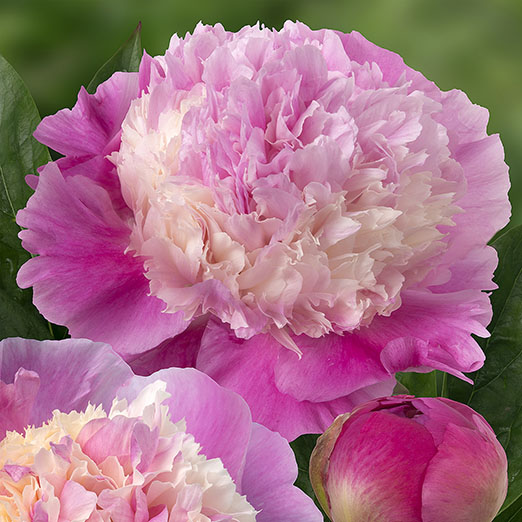How to grow Blueberries (Vaccinium)
Harvesting homegrown, sweet blueberries is a delight in summer. These dark little berries are rich in antioxidants and incredibly good for you, whether you choose to eat them straight from the bush or add to healthy breakfasts or dishes, they are delicious - nothing beats the taste of fresh, homegrown fruit.
Blueberry plants are easy to grow and the foliage in autumn provides an interesting splash of colour in the garden border or in a pot. Plants reach around 1 metre high and are therefore perfect for smaller gardens.

Key Information
Soil pH
Position
Hardiness


Where & when to plant Blueberries
Blueberry plants can be grown in a bed or pot at any time of the year, as long as the soil is not frozen. Pot grown shrubs are easier to bring undercover in winter for protection from harsh weather and cold temperatures.
These acid-loving shrubs require a soil pH level between 4 and 5.5. This can be monitored using a meter or soil-testing kit.
Blueberries perform best when grown together with several other varieties 1.5m apart, which greatly aids pollination and will prolong the picking season.
Whether you are growing plants in a pot, border or bed, blueberries need a sunny spot to thrive - they can tolerate a little shade, but the best fruit and autumn colours are gained by growing in a sun-baked area.
Blueberries are happiest grown in light sandy or chalky soil types. If you garden on heavy clay, the best option would be to grow your plants in pots rather than in the ground.
How to plant Blueberries
If you choose to grow your plant in a pot, choose a container with holes in the bottom which is at least 30cm deep and wide. Add a few crocks to the base of the pot for drainage, then a thick layer of ericaceous compost. Gently tease your young shrub from its pot, loosening the roots to encourage growth and place in your container. Fill in around the edges with more ericaceous compost, firm the plant in and water generously with rainwater. As your plant grows and fills the pot, it can be re-potted every few years.
If you are growing in open ground such as a bed or border, then you will need to ensure you achieve the correct soil pH level prior to planting. This can be checked with a pH monitor, or soil testing kit. You can amend your soil with sulphur chips, ericaceous compost, or organic matter such as leaf mould, composted pine needles or clippings. Do not add rich material such as manure. Plant using the same instructions above for pot-grown plants.

What to plant with Blueberries
Blueberries work especially well in the garden when grown in groups or pots and provide interest for most of the year with their pretty spring flowers, delicious summer fruit and beautiful foliage in autumn. They also work well when planted as low hedging.
Because the plants thrive in ericaceous soil, they make great companions for growing next to other acid-loving shrubs such as Rhododendrons, Camellias, Pieris, Azaleas, Hydrangea, Heathers, Magnolia and Skimmia.
Please contact our wonderful Customer Care Team if you would like any further help or planting ideas for your Blueberry plants.



How to care for Blueberries
Blueberries like their soil to be kept moist but not soggy so try to avoid it drying out between watering, but ensure drainage is good. Water with rainwater as tap water will raise the pH level too much due to its lime content.
If your blueberry plants are being grown in a pot, feed once or twice a month with liquid ericaceous feed. Dilute and water the feed onto the soil according to directions on the bottle.
Plants grown directly into the ground will benefit from an annual mulch in early spring with ericaceous matter and a liquid feed to maintain soil acidity levels.
Pruning is not required until your plants are 2-3 years old and should always be carried out in early spring. Firstly, prune out any damaged, dead, or weak stems, then prune around a quarter of the stems back to the base of the plants. Choose older, faded-grey stems to trim away as these will be the least productive. Any shoots being sent out horizontally by the plant can also be removed.
You can expect your plants to bear fruit in the first year, even a small crop is joyful to pick and eat. Yields will increase year on year. From midsummer, the fruits will begin to ripen. Pick darker berries first and leave the harder green berries to continue ripening on the bush until ready to harvest.
Protect your plants with netting or a fruit cage if birds become a problem for your ripening blueberries.
If your blueberry plant is a tender variety, then it will require winter protection and ideally moved into an unheated greenhouse if it is pot grown for the coldest months. Plants grown in the ground can be protected with horticultural fleece if particularly low temperatures are expected, especially when the flowers are forming in spring.
How to propagate Blueberries
The best way to propagate blueberries is by taking cuttings from larger, healthy plants.
Softwood cuttings can be taken in early summer. Remove a cutting 10-15cm long with a sharp knife, ensuring you take a piece of the woody stem (heel) with it. Remove the lower leaves and the tip if it is soft.
Dip the end into hormone rooting powder or gel and insert it into a pot of peat-free compost with plenty of added grit and sand. Water the pot and place it in a shaded spot in your greenhouse or cold frame to take root. Mist cuttings regularly to keep them moist until they have rooted, which should be by autumn. The cuttings can be potted on into a larger pot until you are ready to plant it out.
Hardwood cuttings can be taken by removing healthy shoots known as whips in late winter which are cut into 10-15cm lengths. Pot up each cutting in the same way as softwood cuttings and place in a bright sheltered spot such as a greenhouse to take root and grow on.




